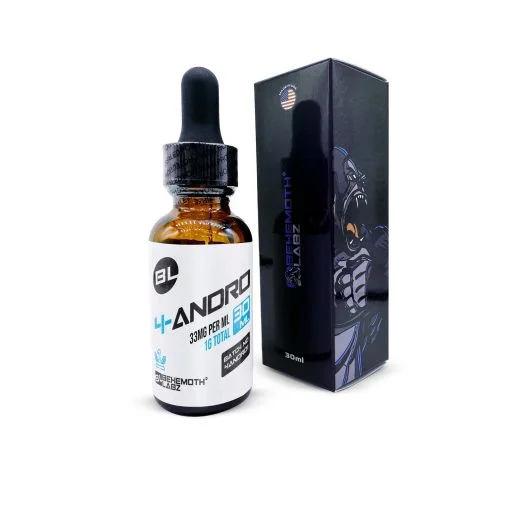SARMs
SARMs VS Testosterone: A Detailed Comparison
In the medical field, scientists are currently investigating SARMs and testosterone for their hormonal impacts and physiological changes in preclinical models. While testosterone is naturally produced, SARMs are synthesized in the laboratory. Despite being differently synthesized, they share similarities and differences.
Let us discuss the nature, structure, functions, key similarities, and differences of SARMS Vs Testosterone in this blog.
What are SARMs?
SARMs are synthetic compounds that stand for Selective Androgen Receptor Modulators. They are currently under clinical trials for various therapeutic conditions. They were developed as a replacement for the traditional steroids. They have a unique feature of binding to androgen receptors only in muscle and bone tissue in preclinical models.
This selective nature restricts their influence to muscle hypertrophy and skeletal health, and helps prevent prostate-related implications in experimental models. Apart from that, they are available in liquid, capsule, and injectable forms. Selection among these forms depends on the nature of the experiment, the health conditions of preclinical models, and the environment.
What is Testosterone?
Testosterone is a naturally occurring sex hormone. Its production occurs when Luteinizing Hormone (LH) from the pituitary gland signals the testes to release it. In case of low testosterone levels, the condition is known as hypogonadism. In such a case, Testosterone Replacement Therapy (TRT) may be prescribed.
In TRT, testosterone is similar in nature, structure, and function to naturally occurring testosterone. But researchers must recognize that TRT is a prescribed medical treatment administered in a controlled environment.
Mechanism of Action
SARMs:
After being administered to preclinical models, SARMs may bind with androgen receptors in muscle and bone tissues. In muscle cells, this binding may influence protein synthesis, which is crucial for repair, regeneration, and preservation of lean muscle mass in preclinical models. In bone tissue, they affect osteoblast activity, which impacts osteoporosis (bone loss) in experimental models. In addition, SARMs may bind to androgen receptors in adipocytes, thereby altering lipolysis. Lipolysis is the breakdown of large fatty acid molecules into smaller ones.
Testosterone:
After being administered to preclinical models, testosterone may bind to various androgen receptors. This binding influences pathways of gene expression involved in multiple physiological changes in preclinical models. Besides, this binding may also impact the patterns linked with muscle hypertrophy, bone integrity, and libido during the experiment.
Potential Benefits/Research Applications of SARMs and Testosterone
The potential benefits/research applications are as follows:
Research Applications of SARMs:
Cachexia (Muscle Wasting Disorder):
SARMs have been investigated for their potential in addressing cachexia in experimental settings. Early studies suggest they may influence protein synthesis in muscle cells in preclinical models. Through their potential to modulate protein synthesis, SARMs affect parameters associated with muscle mass preservation in preclinical models.
Skeletal Health and Bone Integrity:
SARMs have also been demonstrated to affect osteoblast cell activities in experimental settings. Osteoblast cells synthesize and preserve the organic components of bone tissues. By altering osteoblast cell activity, SARMs have affected parameters involved in skeletal health in preclinical models.
Fat Reduction and Metabolism:
SARMs have also been shown to reduce adipose tissue in laboratory studies. In early studies, they have altered lipolysis patterns in preclinical models. In preclinical models, SARMs have broken down large fatty acids into smaller ones in laboratory experiments.
Potential Repair and Regeneration:
In preclinical studies, scientists observed that SARMs affect protein synthesis in muscle cells. This helps repair damaged fibers or form new ones in preclinical models. As a result, repair and regeneration processes may be observed in experimental settings.
Research Applications of Testosterone:
Hypogonadism:
Hypogonadism refers to a low testosterone level. In case of hypogonadism, researchers are investigating the preclinical models with Testosterone Replacement Therapy (TRT). In TRT studies, researchers observed that the low-level testosterone gap was filled in preclinical models.
Potential Muscle Hypertrophy:
In preclinical settings, researchers observed that testosterone binds to androgen receptors in muscle cells, potentially affecting protein synthesis. With improved protein synthesis, researchers identified a potential reduction in muscle breakdown and an increase in lean muscle mass in preclinical models.
Sexual Health and Libido:
The low testosterone levels also affect sexual health and libido (low sexual drive). When testosterone was administered to preclinical models, it affected the base level of natural testosterone. This impacted the overall sexual health and libido in preclinical models.
Mood Changes:
Low testosterone level also results in mood changes, such as anxiety and depression. When this level is balanced or improved, the mood automatically changes. In this regard, researchers have hypothesized, based on early studies, that improved testosterone levels may also affect mood changes in preclinical models.
Comparison of SARMs and Testosterone
Although they influence similar pathways in preclinical models, SARMs and testosterone differ. Here is a detailed comparison of their differences:
Key Differences Between SARMs and Testosterone |
||
| Differences | SARMs | Testosterone |
| Nature and Structure | SARMs are designed in the laboratory and have the potential to bind androgen receptors in muscle and bone tissues in preclinical models. | On the contrary, testosterone is naturally produced and is responsible for sexual health in preclinical models. |
| Purpose | The purpose of the investigation on SARMs is to understand their impacts on muscle hypertrophy, skeletal health, and bone integrity in preclinical models. | On the other hand, testosterone is being studied for its potential in hypogonadism and physiological changes in preclinical models. |
| Mechanism of Action | SARMs bind with androgen receptors only in muscle, bone, and fat cells in preclinical models. | Testosterone binds with androgen receptors everywhere. |
| Regulatory Status | SARMs have not been approved by the FDA for human consumption. | Testosterone is a prescribed medical treatment. The FDA approves it. |
| Effects on the Endocrine System | SARMs have a mild impact on the endocrine pathways in preclinical models. They may temporarily suppress the natural testosterone levels in preclinical models. | Testosterone directly affects the endocrine system. Therefore, it may suppress the natural testosterone levels. |
| Side Effects | SARMs have side effects, such as nausea, headache, fatigue, and hormonal imbalance in preclinical models. | Testosterone has side effects, like water retention, mood swings, liver toxicity, and infertility if not correctly treated in preclinical models. |
Associated Side Effects of SARMs and Testosterone
The associated side effects of SARMs and testosterone are as follows:
| Side Effects of SARMs | Side Effects of Testosterone |
| Nausea | Gynecomastia |
| Headache | Suppression of natural testosterone |
| Fatigue | Water retention |
| Hormonal fluctuation | Liver disturbances |
| Dizziness | Sleep disturbances |
| Acne | |
| Liver toxicity |
Legal Status
Regarding the legal status of these compounds, SARMs have not been approved by the FDA for human use. However, scientists can use them for laboratory studies. In contrast, testosterone is used as a prescribed medical treatment for hypogonadism because it is FDA-approved.
Which Option is Better: SARMs or Testosterone
The best option depends upon various parameters, including safety profile, potential benefits, and regulatory status. In the case of regulatory status, testosterone is the best option, since it is FDA-approved. However, it may also cause side effects due to its non-selective binding to androgen receptors throughout the system. On the other hand, SARMs are experimental compounds that exhibit selective affinity for androgen receptors. Therefore, they have shown a safe profile in preclinical settings.
Final Thought
SARMs and testosterone share some similarities and differences. In cases of similarity, they have shown similar potential benefits, including muscle hypertrophy and skeletal health. But they also differ in nature, structure, and mechanism of action. Besides, testosterone is a prescribed medical treatment, whereas SARMs are experimental compounds and are still under preclinical trials.
Frequently Asked Questions
Where can I buy SARMs online for my laboratory studies?
You can buy SARMs from behemothLabz online. Here, all the products are verified by an independent laboratory for their purity, quality, and integrity.
How do SARMs work?
SARMs bind with androgen receptors only in the muscle and bone tissues in preclinical models. This binding affects protein synthesis, osteoblast cell activities, and lipolysis in preclinical models.
What is testosterone?
Testosterone is a naturally occurring sex hormone produced by the testes. It has the potential to affect overall sexual health, fertility, and other physiological changes in preclinical models.
What is TRT for testosterone?
TRT stands for testosterone replacement therapy. It is used to fill the gap of low testosterone levels (hypogonadism) in preclinical models.
What is the purpose of SARMs?
The purpose of SARMs is to investigate their potential for muscle hypertrophy, skeletal health, and bone integrity in preclinical models.
Do SARMs cause liver damage in preclinical models?
Some early studies have shown that SARMs may affect liver function to some extent in preclinical models. However, to support this claim, studies are still underway in preclinical models.
References:
- Narayanan, Ramesh, Christopher C. Coss, and James T. Dalton. “Development of selective androgen receptor modulators (SARMs).” Molecular and cellular endocrinology 465 (2018): 134-142.
- Gao, Wenqing, and James T. Dalton. “Expanding the therapeutic use of androgens via selective androgen receptor modulators (SARMs).” Drug discovery today 12.5-6 (2007): 241-248.
- Negro-Vilar, Andres. “Selective androgen receptor modulators (SARMs): a novel approach to androgen therapy for the new millennium.” The Journal of Clinical Endocrinology & Metabolism 84.10 (1999): 3459-3462.
- Wen, Jimmy, et al. “Selective androgen receptor modulators (SARMs) effects on physical performance: a systematic review of randomized control trials.” Clinical endocrinology 102.1 (2025): 3-27.
- Freeman, Erica R., David A. Bloom, and Edward J. McGuire. “A brief history of testosterone.” The Journal of Urology 165.2 (2001): 371-373.
- Snyder, Peter J., et al. “Lessons from the testosterone trials.” Endocrine reviews 39.3 (2018): 369-386.










